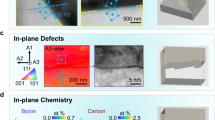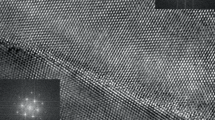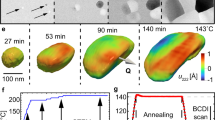Abstract
The ability to resolve spatially and identify chemically atoms in defects would greatly advance our understanding of the correlation between structure and property in materials1. This is particularly important in polycrystalline materials, in which the grain boundaries have profound implications for the properties and applications of the final material2. However, such atomic resolution is still extremely difficult to achieve, partly because grain boundaries are effective sinks for atomic defects and impurities3,4,5, which may drive structural transformation of grain boundaries and consequently modify material properties6,7. Regardless of the origin of these sinks, the interplay between defects and grain boundaries complicates our efforts to pinpoint the exact sites and chemistries of the entities present in the defective regions, thereby limiting our understanding of how specific defects mediate property changes. Here we show that the combination of advanced electron microscopy, spectroscopy and first-principles calculations can provide three-dimensional images of complex, multicomponent grain boundaries with both atomic resolution and chemical sensitivity. The high resolution of these techniques allows us to demonstrate that even for magnesium oxide, which has a simple rock-salt structure, grain boundaries can accommodate complex ordered defect superstructures that induce significant electron trapping in the bandgap of the oxide. These results offer insights into interactions between defects and grain boundaries in ceramics and demonstrate that atomic-scale analysis of complex multicomponent structures in materials is now becoming possible.
This is a preview of subscription content, access via your institution
Access options
Subscribe to this journal
Receive 51 print issues and online access
$199.00 per year
only $3.90 per issue
Buy this article
- Purchase on Springer Link
- Instant access to full article PDF
Prices may be subject to local taxes which are calculated during checkout




Similar content being viewed by others
References
Nellist, P. D. et al. Direct sub-angstrom imaging of a crystal lattice. Science 305, 1741 (2004)
Buban, J. P. et al. Grain boundary strengthening in alumina by rare earth impurities. Science 311, 212–215 (2006)
Kingery, W. D. Plausible concepts necessary and sufficient for interpretation of ceramic grain-boundary phenomena: I, grain-boundary characteristics, structure, and electrostatic potential. J. Am. Ceram. Soc. 57, 1–8 (1974)
Bai, X. M. et al. Efficient annealing of radiation damage near grain boundaries via interstitial emission. Science 327, 1631–1634 (2010)
Jia, C. L. & Urban, K. Atomic-resolution measurement of oxygen concentration in oxide materials. Science 303, 2001–2004 (2004)
Lartigue-Korinek, S., Bouchet, D., Bleloch, A. & Colliex, C. HAADF study of the relationship between intergranular defect structure and yttrium segregation in an alumina grain boundary. Acta Mater. 59, 3519–3527 (2011)
Maiti, A. et al. Dopant segregation at semiconductor grain boundaries through cooperative chemical rebonding. Phys. Rev. Lett. 77, 1306–1309 (1996)
Kaiser, U. et al. Direct observation of defect-mediated cluster nucleation. Nature Mater. 1, 102–105 (2002)
Barth, C. et al. Recent trends in surface characterization and chemistry with high-resolution scanning force methods. Adv. Mater. 23, 477–501 (2011)
Muller, D. A. Structure and bonding at the atomic scale by scanning transmission electron microscopy. Nature Mater. 8, 263–270 (2009)
Kimoto, K. et al. Element-selective imaging of atomic columns in a crystal using STEM and EELS. Nature 450, 702–704 (2007)
Huang, P. Y. et al. Grains and grain boundaries in single-layer graphene atomic patchwork quilts. Nature 469, 389–392 (2011)
Klie, R. F. et al. Enhanced current transport at grain boundaries in high-T c superconductors. Nature 435, 475–478 (2005)
McKenna, K. P. & Shluger, A. L. First-principles calculations of defects near a grain boundary in MgO. Phys. Rev. B 79, 224116 (2009)
Chiang, Y. M., Henriksen, A. F. & Kingery, W. D. Characterization of grain-boundary segregation in MgO. J. Am. Ceram. Soc. 64, 385–389 (1981)
Browning, N. D. et al. Investigating the structure-property relationships at grain boundaries in MgO using bond-valence pair potentials and multiple scattering analysis. J. Am. Ceram. Soc. 82, 366–372 (1999)
Yan, Y. et al. Impurity-induced structural transformation of a MgO grain boundary. Phys. Rev. Lett. 81, 3675–3678 (1998)
Duffy, D. M. Grain boundaries in ionic crystals. J. Phys. C 19, 4393–4412 (1986)
Yamakov, V. et al. Dislocation processes in the deformation of nanocrystalline aluminium by molecular-dynamics simulation. Nature Mater. 1, 45–49 (2002)
Kizuka, T., Iijima, M. & Tanaka, N. Atomic process of electron-irradiation-induced grain-boundary migration in a MgO tilt boundary. Philos. Mag. A 77, 413–422 (1998)
Ortalan, V. et al. Direct imaging of single metal atoms and clusters in the pores of dealuminated HY zeolite. Nature Nanotechnol. 5, 506–510 (2010)
Colliex, C. Elementary resolution. Nature 450, 622–623 (2007)
Findlay, S. et al. Robust atomic resolution imaging of light elements using scanning transmission electron microscopy. Appl. Phys. Lett. 95, 191913 (2009)
Ishizuka, K. & Uyeda, N. A new theoretical and practical approach to the multislice methods. Acta Crystallogr. A 33, 740–749 (1977)
Pennycook, S. J. & Boatner, L. A. Chemically sensitive structure-imaging with a scanning transmission electron microscope. Nature 336, 565–567 (1988)
Davies, J. J. & Wertz, J. E. The EPR spectrum of trivalent titanium in orthorhombic symmetry in MgO. J. Phys. Chem. Solids 31, 2489–2494 (1970)
Tanaka, I. et al. Identification of ultradilute dopants in ceramics. Nature Mater. 2, 541–545 (2003)
Vitek, V. & Wang, G. J. Segregation and grain boundary structure. Surf. Sci. 144, 110–123 (1984)
McKenna, K. P. & Shluger, A. L. Electron-trapping polycrystalline materials with negative electron affinity. Nature Mater. 7, 859–862 (2008)
Harris, D. J., Watson, G. W. & Parker, S. C. Atomistic simulation of the effect of temperature and pressure on the [001] symmetric tilt grain boundaries of MgO. Phil. Mag. A 74, 407–418 (1996)
Acknowledgements
This work was supported in part by a Grant-in-Aid for Scientific Research on Priority Area “Atomic Scale Modification (474)” from MEXT, Japan. We thank T. Mizoguchi for performing electron energy-loss near-edge structure simulations and for discussions, and T. Saito and W. Zeng for experimental assistance. Z.W. acknowledges support by a Grant-in-Aid for Young Scientists (B) (grant no. 22760500) and from IZUMI Science Foundation. M.S. is grateful for a Grant-in-Aid for Scientific Research (C) (grant no. 23560817) and to MURATA Science Foundation for financial support. K.P.M. acknowledges support by a Grant-in-Aid for Young Scientists (B) (grant no. 22740192). S.T. thanks supports from the Nippon Sheet Glass Foundation. Calculations were conducted at ISSP, University of Tokyo.
Author information
Authors and Affiliations
Contributions
Z.W. prepared specimens, carried out calculations and wrote the manuscript. M.S. made images and conducted image simulation and processing. K.P.M. and A.L.S. helped with the calculations and discussed the results. L.G. and S.T. helped with the experiments. Y.I. discussed the results and directed the entire study. All the authors read and commented on the manuscript.
Corresponding author
Ethics declarations
Competing interests
The authors declare no competing financial interests.
Supplementary information
Supplementary Information
The file contains Supplementary Materials and Methods, Supplementary Text, Supplementary Figures 1-4 with legends, Supplementary Table 1 and additional references. (PDF 922 kb)
Rights and permissions
About this article
Cite this article
Wang, Z., Saito, M., McKenna, K. et al. Atom-resolved imaging of ordered defect superstructures at individual grain boundaries. Nature 479, 380–383 (2011). https://doi.org/10.1038/nature10593
Received:
Accepted:
Published:
Issue Date:
DOI: https://doi.org/10.1038/nature10593
This article is cited by
-
Structural transition and migration of incoherent twin boundary in diamond
Nature (2024)
-
Diamond: asymmetry leads to continuous hardening
Science China Materials (2024)
-
Atomic motifs govern the decoration of grain boundaries by interstitial solutes
Nature Communications (2023)
-
An unconstrained approach to systematic structural and energetic screening of materials interfaces
Nature Communications (2022)
-
Grain boundary structural transformation induced by co-segregation of aliovalent dopants
Nature Communications (2022)
Comments
By submitting a comment you agree to abide by our Terms and Community Guidelines. If you find something abusive or that does not comply with our terms or guidelines please flag it as inappropriate.



